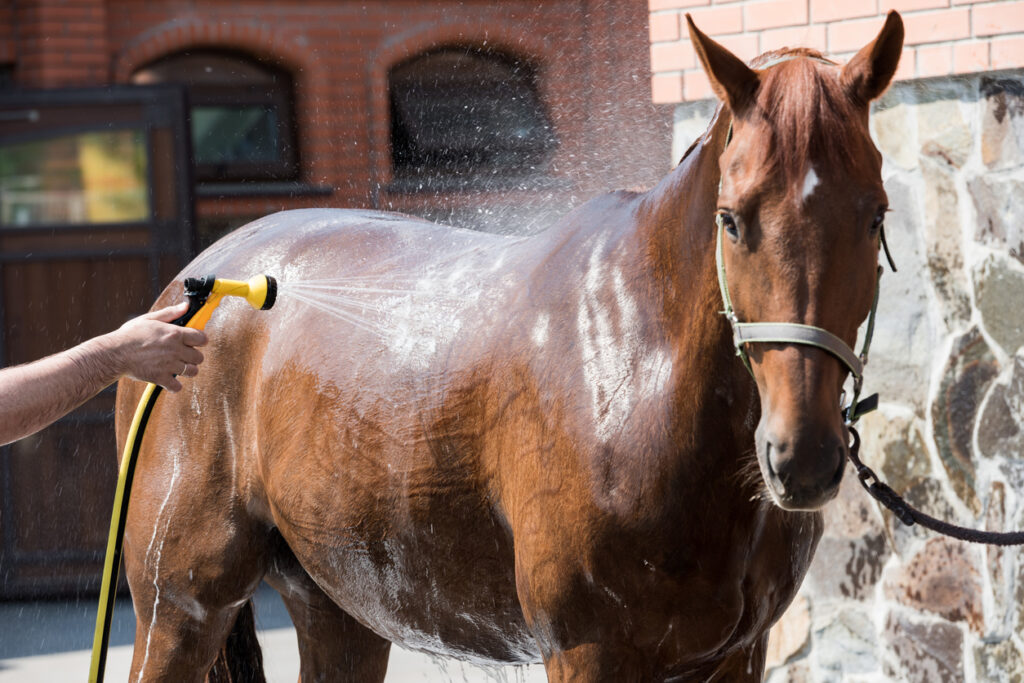How to Bathe a Horse
Bathing a horse is an enjoyable experience for both the owner and the horse. It is also a crucial part of caring for horses, and should be done on a regular basis, particularly in the summer when they tend to sweat more. Bathing gives you the chance to check for any skin injuries, wounds, or lumps that may have gone unnoticed during regular grooming, as well as to keep your horse’s coat clean, healthy, and shiny. This article will look at the procedures you must adhere to in order to effectively bathe a horse.
Step 1: Gather Your Supplies
Before you start bathing your horse, you’ll need to gather all the necessary supplies. Here’s what you’ll need:
1. A Hose
A tube with a spray nozzle, or a specialized horse bath hose that is designed to be used with equine shampoo.
2. Shampoo
There are many different kinds of equine shampoos on the market; choose the best one for your horse based on the type of coat and any skin conditions they may have.
3. A Bucket
You will need a bucket to hold the shampoo solution.
4. Sponge or Scrub Brush
You will use a sponge or scrub brush to apply the shampoo to your horse’s coat.
5. A Sweat Scraper
A sweat scraper is a tool used to get rid of excess water from your horse’s coat.
6. Towels
You will need towels to dry your horse off after the bath.
7. Halter and Lead Rope
You will need a halter and lead rope to keep your horse under control while you are bathing them.
Step 2: Choose the Right Location
When it comes to bathing a horse, you must choose a location that’s safe, secure, and comfortable for your horse. Ideal locations include a wash stall or a secure area with excellent drainage. You can use a grassy area with proper drainage if you don’t have access to a wash stall. Avoid washing your horse on a slippery floor or in concrete as this could result in harm or other damage.
Step 3: Prepare Your Horse
It’s crucial to get your horse ready before you begin washing them. Start by using a brush or curry comb to remove any dirt or debris from their hair. If there are tangles in the horse mane and tail extricate them using detangler spray and brush out the knots using fingers or a comb. Use a hoof pick to take care of their hooves next. Finally, safely tether your horse to a solid wall or stake.
Step 4: Wet Your Horse
It’s time to commence the bath once you’ve finished grooming. Wet your horse completely using a hosepipe or a big bucket of water. Water in the ears or eyes should be avoided as this can be uncomfortable and possibly dangerous. Start with the legs to help him get adjusted to the water’s temperature and proceed to work your way up to other areas while making sure to wet the complete body. Use a soft touch and a sponge instead of the hose when you get to the face because horses don’t like a hose in their face, just as we wouldn’t.

Step 5: Apply Shampoo
Once your horse is thoroughly wet, it’s time to apply the shampoo. Make use of a sponge or washcloth to apply gentle horse shampoo to your horse’s hair. Make sure to lather the shampoo, paying close attention to any greasy or filthy areas. Start with the neck, then use circular motions to work your way down to the legs gently. When applying shampoo to the face make sure it does not come into contact with the eyes, ears, or mouth. Apply the shampoo with your palms over the horse’s face if they are accustomed to you petting its face.
Step 6: Hose Off the Shampoo
After applying the shampoo, give your horse a good rinse. Rinse off all the shampoo using a hosepipe or a sizable container of clean water. Make sure to completely rinse your horse’s coat to remove any shampoo residue, which could lead to dryness or irritation.
Step 7: Apply Conditioner (optional)
Apply the conditioner after rinsing the shampoo off if you want some extra shine. Pour it with the same technique you applied to the shampoo.
Step 8: Use a Sweat Scraper
After you’ve rinsed your horse, it’s time to use a sweat scraper. A sweat scraper is a tool that’s used to flush out excess water from your horse’s fur. Start at the neck and work your way down, using the sweat scraper to remove as much water as possible. This will accelerate the drying process, and it’s important to pay attention to any potential water-trap areas like the underbelly and the space between the legs.
Step 9: Dry Your Horse
Drying your horse is necessary after using a sweat scraper. Dry the coat of your horse with a fresh towel, making your way down from the neck. Dry your horse completely, particularly if the weather is cooler.
Step 10: Apply Fly Spray
After completing drying apply the fly spray on the horse coat to repel the insects away.
Step 11: Brush Your Horse
After your horse is dry, use a soft brush to remove any remaining dirt or debris from their coat. This will help to keep their coat looking shiny and healthy.
Step 12: Check Your Horse’s Hooves
Finally, after you’ve finished bathing and brushing your horse, it’s important to check their hooves again. Make sure that there’s no debris or dirt left inside their hooves and use a hoof pick to remove any buildup.
Step 13: Reward the horse.
You should give your horse a treat, a pat on the neck, or additional attention after you’ve finished the entire bathing procedure to acknowledge them for their good behavior.
Conclusion
Although giving a horse a bath may seem like a difficult job, it is an essential procedure in regular horse grooming. By following the steps outlined in this article, you’ll be able to bathe your horse effectively and keep their coat clean and healthy. Simply follow the proper procedures, and the experience will be simple and pleasant for both the horse and the owner.
If you are located in Yavapai County and need advice on caring for your horse, contact Chino Valley Animal Hospital. Our veterinarians are experts at equine care and can help. Call us today at (928) 636-4382, or Request an Appointment Online today!




